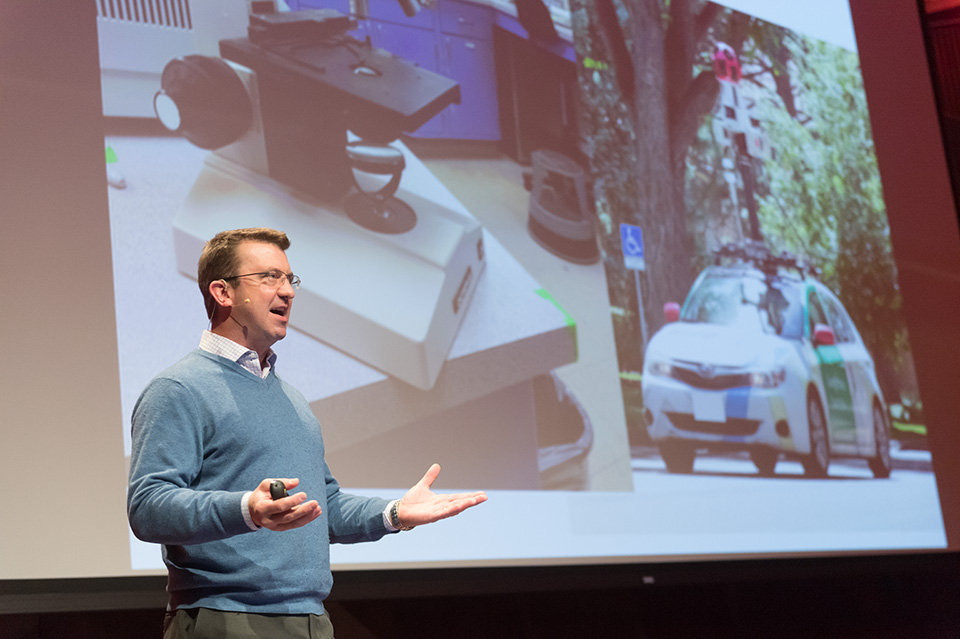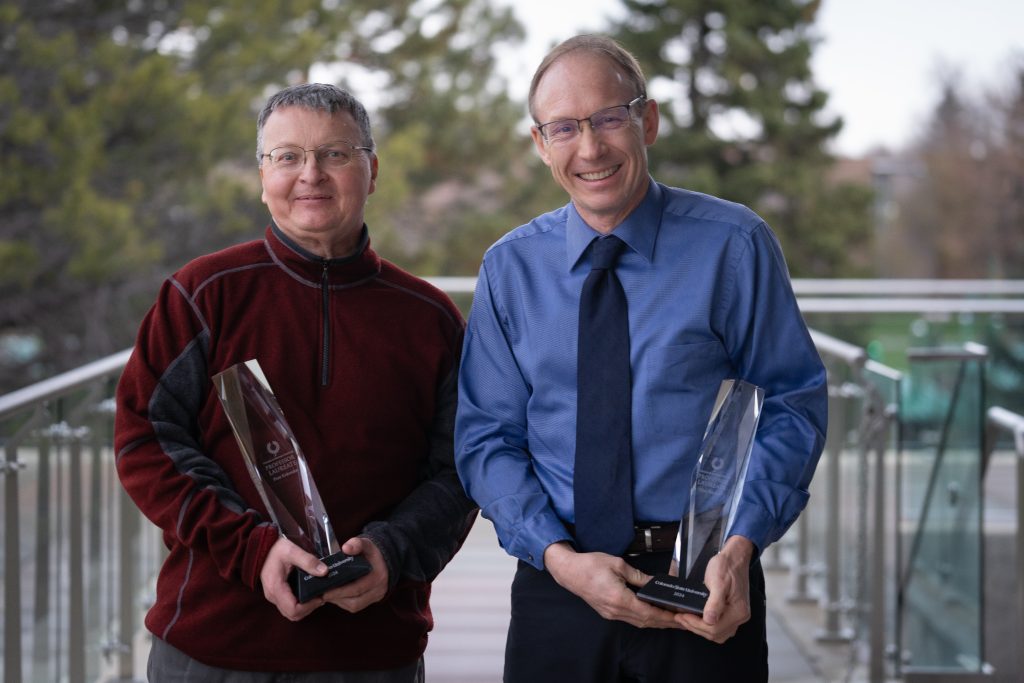
The Greenhouse Gas to Beat
Adapted from a podcast by Stacy Nick.
Methane is odorless, colorless and invisible to the naked eye. It’s also one of the most damaging greenhouse gases impacting climate change.
Colorado State University biology professor Joe von Fischer researches how humans, plants, soil and soil microbes influence greenhouse gas emissions, including methane.
Methane, as von Fischer says, may be a big key to getting climate change under control.
“The reason is that if you release a pound of CO2 into the atmosphere, it’s going to go up and spend about 100 years there. But methane, in contrast, only spends on average of about 10 years in the atmosphere,” explains von Fischer.
“It spends less time in the atmosphere, meaning that if we cut off our methane emissions, we could reduce the concentration in the atmosphere rapidly and give ourselves a little bit more time to manage CO2, which is a more complicated gas.”
Von Fischer has studied methane since he was in graduate school, and he affectionately refers to it as his favorite gas.
His research has taken him from the lab to experiments around the U.S. including a collaboration with Google to add methane detectors on Google Street View cars.
“We’ve worked to analyze that data, and we found that methane emissions from the natural gas infrastructure are really common in cities,” said von Fischer.
“We found that there is on the order of 700,000 natural gas leaks in the U.S. at any given moment.”
This research has given von Fischer a new role, as well, as the “friendly neighborhood scientist.”
“One of the cool things about being at a land-grant university like CSU is part of my job is to be the friendly neighborhood scientist. It’s about outreach. It’s about connecting with people where the science that we do is directly relevant.”
Podcast Transcript
Methane is odorless, colorless, and invisible to the naked eye. But it’s also one of the most damaging greenhouse gases impacting climate change.
Colorado State University biology professor Joe Von Fischer researches how humans, plants, soil and soil microbes influence greenhouse gas emissions, including methane. Today, we’re talking with Von Fischer about how methane compares to the more notorious carbon dioxide, his research into ways we can better measure methane emissions, and why measuring and reducing methane is a critical opportunity in the climate fight.
Host Stacy Nick: Hi, Joe. Thanks for being here.
Joe Von Fischer: Thanks for having me, Stacy.
So, when we were chatting ahead of this interview, you told me that methane is your favorite gas, and I need to know why, because that’s not something you usually hear people say.
I know people are surprised when I declare a favorite gas. I think methane is my favorite gas because I’ve been studying it since grad school. I learned at that time that methane is a byproduct of microbial breakdown, organic matter in places like soils where there isn’t enough oxygen to metabolize. You and I would eat an Oreo cookie, burn it in our mitochondria, consume oxygen and generate power for our activities. But these microbes in the soil don’t have any oxygen, and part of their metabolic processes yield methane as a byproduct.
Methane is a crazy little gas. It’s a carbon atom and four hydrogen atoms. You see it abbreviated chemically as C-H four, and it’s an incredible amount of stored energy. You pack those four hydrogens next to a carbon atom, and there’s a lot of reducing power stored in that one carbon atom as a result. We burn methane. Methane is a chief ingredient in natural gas. We burn it in our hot water heater so we can take a hot shower in the morning, and a lot of that stored energy is either put there by the microbes, or it’s put there during the geologic processes that yield natural gas that we harvest.
Why has it become such an important area to study in regard to climate change?
Well, methane is a greenhouse gas. What that means is that those hydrogen carbon bonds that I was talking about, they vibrate at a certain frequency, and they happen to vibrate at the same frequency as the photons that are emitted by the Earth. The Earth, like any object warmer than absolute zero, emits heat photons away from itself. That’s radiative cooling.
Now, if this radiative cooling went all the way to space, the Earth would have a lower temperature. But some of those heat photons which vibrate at a certain (hums) frequency, matches the (hums) frequency that methane resonates at. Those photons being released from the Earth are trapped by methane in the atmosphere. The methane in the atmosphere warms up and reradiates heat back down to Earth. Methane, carbon dioxide, nitrous oxide, sulfur hexafluoride, these are all greenhouse gases because they have that (hums) feature. So, the more methane is in the atmosphere, the more CO2, the greater that absorptive capacity and the greater the warming that happens as a consequence.
How does that influence our current interest in atmospheric methane? The reason is that if you release a pound of CO2 into the atmosphere, it’s going to go up and spend about 100 years in the atmosphere, which is quite a long time. But methane, in contrast, reacts in the atmosphere and only spends on average about ten years in the atmosphere. That means that in order to maintain the methane levels that we’re at right now, which are pretty high, we need to have a constant source of methane.
If we were to cut off that source by managing methane emissions as a planet of humans, we could reduce the concentration of methane rapidly and give ourselves a little bit more time to manage CO2, which is a more complicated gas. It spends less time in the atmosphere. That means if we cut off our supply, we’ll cut down the concentration more rapidly than we would for CO2.
So, reducing methane has a more, maybe immediate impact.
That’s exactly right. And so, slowing the pace of warming is important, not just giving us time to manage CO2, but also if we think about the positive feedback between climate change and the Earth’s systems, then we also reduce the magnitude of those amplifications that happen naturally in the planet.
Why is methane different from carbon as far as greenhouse gases go? Why is one kind of become seemingly more critical to address than the other? You hear about carbon credits. It’s just that it’s much more of a buzzword than methane.
It is. The idea of carbon credits is the idea that that there should be some actions taken to pull carbon dioxide out of the atmosphere. Are there engineering or biological principles that we could operate or deploy on a global scale? Could we plant trees? Could we plow biochar into the soil? Are there other mechanisms like that that would take the CO2 from the atmosphere and store it long term out of the atmosphere? There’s been a lot of traction on that. But recently we’re seeing new legislation to start to manage methane emissions as well.
Federally, and in many states, like in Colorado, there are new rules in place to limit the amount of methane emissions. There are also on the carbon offset market mechanisms for companies to get credit, carbon offset credits, by reducing their methane emissions so they can demonstrably show a before and after reduction in methane emissions. They may be able to sell some of those carbon offset credits focused on the methane emissions reductions.
During the past 20 years, there’s been a boom in advancing technologies used to locate and gauge methane emissions in order to work with industries to find better ways to reduce those emissions.
Methane is, like I said, a greenhouse gas, meaning it absorbs those heat photons in infrared. Imagine that we could see infrared. Imagine we could see the color of heat photons being emitted by the Earth. That would mean that we could see a fog of methane in the atmosphere. If you shine an infrared light through a room filled with methane, it will look foggy. There are new laser-based sensors, and I say laser because they’re able to emit infrared light in a really specific wavelength that matches that (hums) absorption wavelength of methane.
These lasers can often be tunable. They can emit a color photon that’s a little bit higher (hums higher), and maybe not absorbed by the methane. So, they can compare how much light is absorbed when it passes through an air mass by comparing that (hums in several different frequencies). I got the wrong tones, but you get the idea. By comparing those absorption amounts and because there’s something called a per molar absorptivity of methane, in each of these wavelengths we can determine precisely how much methane is in the air.
Since about 2000, there’s been a proliferation of these kinds of technologies that either make toaster-sized boxes for measuring methane, so they’ll suck air through them, or there are cameras that use laser-based absorption. There are new satellites. In fact, the Environmental Defense Fund just launched a satellite last week. Methane Sat it’s called. It’s the first sort of non-governmental or nonacademic satellite that’s designed to look for where there are methane plumes in the planet, identify where these sources are, and hopefully bring about remediation.
And you used infrared sensors as part of your research with the Environmental Defense Fund, literally putting them kind of atop Google Street View cars and driving them around looking for methane leaks. So, tell me a little bit about that project. I’m trying to imagine what that would look like.
Oh, that was a great project. We were really lucky to work with the Google Street View program and my colleagues at Environmental Defense Fund. It started because in 2007, I bought one of these laser-based methane analyzers. It was one of the very first generations, and it was huge. It was the size of a suitcase you might wish you didn’t have to drag along to Europe if you’re traveling there for a month. It was really large.
We took it across the Arctic tundra, we powered it off car batteries, and we found a huge diversity in the rates of methane emissions across the Arctic tundra. Then when we brought it back to CSU, it was great. The device allowed us to make real-time measurements of methane concentration, and I realized there was potential to do entirely different kinds of measurements of methane from the atmosphere.
We put it in our lab truck and drove it around town. We found a brewery, which shall remain nameless, that was fermenting some of its waste grains and producing methane as a product in order to burn it and generate their onsite electricity. What they didn’t realize was that some of that was leaking, and we found elevated methane readings around this brewery, and we told them about it. We were able to go on site and help them find which part of their facility was leaking, and they were able to tighten up the flanges and make that emission go away.
That, to me, was a transformational experience because I went from being sort of a biologist working on tundra methane emissions or things like that to someone who was actually making a change in human methane emissions. That moment changed my career. It led me to understand that there were things that I could do with my science to help find what humans were doing to the atmosphere and to bring about reductions in emissions.
When an Environmental Defense Fund scientist came to CSU and we talked about my interest in doing this with cars, he told me about an emerging project they had with the Google Street View program. Putting methane sensors on vehicles. I led the science side of that project in partnership with Google and Environmental Defense Fund, to see what information you could gather when you put a methane sensor in the trunk of a Google Street View car and a GPS unit and a wind sensor, and you drive around neighborhoods in different cities.
Through that Google Street View project, there were a couple of really new types of collaborations that emerged. One of them was with my colleagues here at CSU. Not only was I working with my colleagues in computer science and atmospheric science, but I also started working collaboratively with people outside the university. People at Google or people at Environmental Defense Fund, or people at the industries that were that were doing the emissions.
One of the cool things about being at a land-grant university like CSU is part of my job, is to be the friendly neighborhood scientist. It’s about outreach. It’s about connecting with people where the science that we do is directly relevant. We might hypothesize that some innovation in the way that the natural gas industry conducts its leak surveys might bring about a reduction in their total emissions. That’s a hypothesis that I’ve tested in collaboration with those industry partners, and we found pathways to reduce emissions. As I’ve said before, you can’t manage what you don’t measure, and we’ve helped through our science, through CSU’s outreach to help those companies manage their emissions.
Where did you find the most surprising locations?
It was really interesting to see that data come through. It was a new kind of data. You drive down the street and there’s a new reading that’s coming into your instrument every second. It generates a lot of data. Working with colleagues here at CSU and atmospheric sciences, with the wind and in computer science Sangmi Pallickara, for example. We developed algorithms to screen all that data. Then I worked with statisticians, Zach Weller, for example, who was a grad student at the time and then became a postdoc and a research scientist and is still a collaborator of mine.
We’ve worked to analyze that data, and we found that methane emissions from the natural gas infrastructure are really common in cities. After having driven 16 cities across the U.S., Zach and I did an analysis and estimate that at any given time in the U.S., there are over. Well, I should make you guess. How many natural gas leaks do you think there are in the country right now?
Oh, uh. A thousand?
We found that there is on the order of 700,000 natural gas leaks in the U.S. at any given moment, and for the most part, natural gas leaks don’t blow up. For the most part, they exist on parts of the infrastructure where the gas vents directly to the atmosphere, and it can be a safety concern. Of course, all the natural gas utilities conduct regular safety reviews to find where those gases are coming from. To identify the severity of the leak and to repair it either immediately or as soon as they can, depending on that severity.
But what we found in a surprising analysis was when we looked at the abundance of natural gas leaks, we found that there was a higher abundance of natural gas leaks where there were a higher percent people of color in these neighborhoods. We used U.S. Census Bureau data to analyze what we call environmental justice or social justice metrics, looking at income, percent people of color, language, age of occupants of these different neighborhoods. And we found that it wasn’t population density, it wasn’t age of housing, but that cryptically and concerningly it was percent people of color where there are higher percent people of color, there would be more natural gas leaks.
That environmental injustice or infrastructure injustice is something that I’m interested in working with regulators and the utilities to understand the origins of and to remedy. It’s one more injustice that I think these vulnerable communities are facing. And I think, as they say, you can’t manage what you don’t measure. I’m excited about our measurement technology and approaches and the use of census tracks as an analytical tool that regulators or the utilities themselves can use to identify the degree to which their infrastructure is a just infrastructure.
You know, we’ve talked about some of the different sources of methane. The oil and gas and animal production industries are two of the biggest contributors of methane. But what are some of the other more surprising sources?
Well, you left out landfills from your list. Landfills are a really important part. I think in the U.S. methane budget, about a third of the human methane is coming from landfills. Cattle are a big source, and although it’s commonly joked as cow farts, it’s actually cow belches that are the sources. You laugh, but this is deadly serious business.
Oh, yes. (laughing) Okay.
So, what happens is these microbes that I started studying 20 years ago are living in the guts of cattle, or they’re living in landfills, and they are operating, decomposing our garbage in the absence of oxygen and yielding methane as a byproduct. In many landfills, this methane is vented to the atmosphere. In some landfills, the methane is collected and burned on site, or in some places, like the Fresh Kills Landfill on Staten Island the largest landfill in the U.S., and they harvest the natural gas. Then they put that right into the pipes. I’ve heard rumors that in Staten Island, the natural gas that comes out of your stove sometimes smells like garbage, which I find surprising but interesting.
That seems like one area where the general public can really have more impact on an issue. When you think of those first two contributors, the oil and gas industry and animal production, there’s maybe a feeling of helplessness for a lot of people, but we can all control what we throw away.
It’s an interesting phenomenon. We can control what we throw away. We can reduce the amount of organics that we send to the landfill, so those organics don’t get turned into methane. And as a general philosophy, my approach has been to encourage people to turn the valve in front of you. In order for us to manage greenhouse gas emissions or other environmental concerns, there are many things we can do, and it’s hard to say which is the most urgent priority among the different things.
But I think we each have a valve. We could decide to bike to work today. We could decide to turn the heat down in our house. We could decide to install a heat pump. We can decide to put less organics into the landfill. There’s a valve in front of you, and you can turn one or more of them as your ability is able. If you’re an executive in charge of a large oil and gas company, you have different valves in front of you, and hopefully we can convince those people to turn down those valves as well.
How much of our ability to reduce methane emissions and halt climate change is actually in our control at this point? I know that’s a that’s a big question, but…
Control is an interesting question. It’s about, to some degree, how much agency we have in our everyday life. It’s about how much capacity we as individuals have for advocating for change. I mean, sometimes I come home from work, and I just want to sit on the couch and play a video game with my boys, right? Having that energy to make change is hard. There are a number of institutional structures that we rely on that are really hard to change.
We see some communities banning natural gas in new construction. That’s happening in California and some places in New York. Is that a good idea? It would reduce demand for natural gas, which is mostly methane, and therefore reduce that leaky chain of connections that brings methane to the end user, to the homes and business. Maybe we can get enough power from solar, but it’s a slow process. What’s in our control?
Again, it comes back to what are the valves in front of you and which valves do you decide to sit in front of? Are you going to sit in front of a valve where you’re working on only your home? Are you going to work on a valve where you’re deciding to legislate or encourage some change at the state or federal level? Are you talking with your friends?
There are a lot of ways that you could think about turning the valve, and a lot of different valves that you might decide to stand in front of. But I could say that we’re talking about a planet that has infrastructure that’s focused right now, and economies are driven by oil and gas. That’s not an easy change to make. It’s not clear that every pivot we might choose to make is actually, in the long run, the best one. It’s not an easy question.
How has it impacted how you see the valve that’s in front of you?
I think the valve that’s in front of me is today a microphone, and I realize that I have an opportunity to help people learn about methane and other greenhouse gases, to realize that it is complicated and not easy to switch. I think you see simplification on both sides. You see people arguing that there is no climate change, and we don’t need a change, which is oversimplified and wrong.
I see people on the other side saying, we need to stop fossil fuels right now. We need to cut them all off, and that would devastate our economy. I think what we need is a path that relies on complexity and nuance. I have a hypothesis that I call the Hamburger Helper hypothesis. Have you ever bought Hamburger Helper?
Not for a long time.
Yeah, I don’t think I have. I think I picked up a box one time, and I shook it, and I realized what’s inside is a box of pasta and a package of spice. You still have to go and buy the hamburger and the tomato sauce. Right? And you bring those home. What Hamburger Helper really is, is a simple way to get dinner on the table. It requires less thought.
I see people picking up Hamburger Helper ideas off the media, when in fact, I think if you’re going to cook a healthy meal for your family, Hamburger Helper is good. But once people realize that it’s just spices and pasta, then it allows them to be creative, and it’s like, oh, I could buy these spices. Oh, I could find a path through. Oh, I might try a different spice.
I think that opportunity for creative expression, the recognition of nuance and the recognition that not all off-the-shelf solutions, including in thought, are the best path forward. I think encouraging people to develop their own pasta and spice and hamburger combinations is going to lead us forward to a place where people aren’t just taking ideas off the shelf. Does that make any sense?
That totally does. Thank you so much for your time, I appreciate it.
It’s great to be here. Thanks for having me.
That was Colorado State University biology professor Joe Von Fischer speaking about his research into methane. I’m your host, Stacy Nick, and you’re listening to CSU’s The Audio Podcast.



